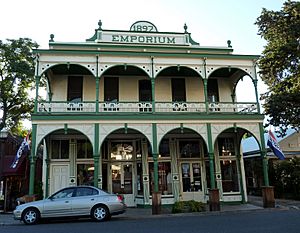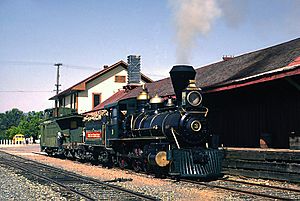Jamestown, California facts for kids
Quick facts for kids
Jamestown, California
|
|
|---|---|

Main Street
|
|

Location in Tuolumne County and the state of California
|
|
| Country | |
| State | |
| County | Tuolumne |
| Area | |
| • Total | 2.996 sq mi (7.761 km2) |
| • Land | 2.994 sq mi (7.756 km2) |
| • Water | 0.002 sq mi (0.005 km2) 0.07% |
| Elevation | 1,427 ft (435 m) |
| Population
(2010)
|
|
| • Total | 3,433 |
| • Density | 1,145.9/sq mi (442.34/km2) |
| Time zone | UTC-8 (Pacific (PST)) |
| • Summer (DST) | UTC-7 (PDT) |
| ZIP code |
95327
|
| Area code(s) | 209 |
| FIPS code | 06-37106 |
| GNIS feature ID | 1658851 |
| Designated: | March 16, 1949 |
| Reference #: | 431 |


Jamestown is a small community in Tuolumne County, California. It is known as a census-designated place (CDP). In 2010, about 3,433 people lived here.
Jamestown was once a busy town during the California Gold Rush. It became a special California Historical Landmark in 1949. Today, it is home to Railtown 1897 State Historic Park. This park has old steam trains that you can ride! The town is also famous for being a filming location for many movies and TV shows.
Contents
Jamestown's Location and Size
Jamestown is located in central California. It covers a total area of about 3 square miles (7.7 square kilometers). Most of this area is land. Only a tiny part is water.
Who Lives in Jamestown?
| Historical population | |||
|---|---|---|---|
| Census | Pop. | %± | |
| U.S. Decennial Census | |||
Jamestown's Population in 2010
In 2010, Jamestown had 3,433 residents. Most people living here were White (about 86%). There were also people from other backgrounds, including Native American, Asian, and African American. About 15% of the population was Hispanic or Latino.
Most of the people lived in homes. Only a few lived in group homes. The average home had about 2 to 3 people.
Jamestown's Population in 2000
Back in 2000, Jamestown had 3,017 people. The population was mostly White (about 91%). There were also Native American, Asian, and African American residents. About 9.5% of the people were Hispanic or Latino.
The average age of people in Jamestown was 42 years old. Many people were 65 or older.
Jamestown in Movies and TV Shows
Jamestown is a popular spot for filming! Many famous movies and TV shows have filmed scenes here.
- Back to the Future Part III: The final movie in the Back to the Future series filmed parts of its story in Jamestown.
- Hidalgo: A movie from 2004 also used Jamestown as a backdrop.
- TV series: Shows like Petticoat Junction, The Wild Wild West, Green Acres, and Little House on the Prairie filmed scenes in and around Jamestown.
The town was also shown in an episode of Road Trip with Huell Howser.
See also
 In Spanish: Jamestown (California) para niños
In Spanish: Jamestown (California) para niños



